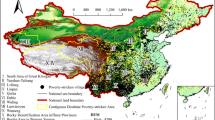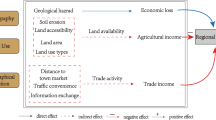Abstract
Spatially-explicit, fine-scale mapping of poor population distribution at a village level is a necessary prerequisite for developing precise anti-poverty strategies in rural China. To address the data missing of poor population at a village scale, we proposed a modeling methodology from the perspective of spatial poverty, integrating BP and MGWR-SL (Mixed Geographically Weighted Regression model with Spatially Lagged dependent variable) that correspond to population estimation and poverty incidence estimation, respectively, to explore a more accurate and detailed village-level poor population distribution. Furthermore, we justified the accuracy, reliability, and scale effects of the model by using GIS spatial analysis and cross-validation. From the case test, we found that, the proposed model could characterize poor population distribution more accurately than other existing methods, resulting in that the errors of both population spatialization and poverty incidence for each village are less than 5% at a 500 * 500 m grid scale. It can also be inferred that the spatialization of socioeconomic data at a fine scale should take into full account of spatial heterogeneity and spatial autocorrelation for both dependent and independent variables, so as to improve the modeling accuracy. This study may provide a perspective for better understanding the detailed and accurate poverty status of data–scarce village in poverty-stricken rural areas, and serves as a scientific reference regarding decision-making in both promoting “entire-village advancement” anti-poverty harmonious development and constructing the new countryside of China.








Similar content being viewed by others
References
Avon, C., Berges, L., & Dupouey, J.-L. (2015). Landscape effects on plants in forests: Large-scale context determines local plant response. Landscape and Urban Planning, 144, 65–73.
Azar, D., Ryan, E., Jordan, G., et al. (2013). Generation of fine-scale population layers using multi-resolution satellite imagery and geospatial data. Remote Sensing of Environment, 130, 219–232.
Bai, Z., Wang, J., Yang, F., et al. (2013). Research progress in spatialization of population data. Progress in Geography, 32(11), 1692–1702.
Cong, F. (1998). Theory and application of neural network for matlab toolbox. Hefei: University of Science and Technology of China.
Dziauddin, M. F., & Powe, N. (2015). Estimating the effects of light rail transit (LRT) system on residential property values using geographically weighted regression (GWR). Applied Spatial Analysis and Policy, 8(1), 1–25.
Erickson, A., Rogers, L., Hurvitz, P., & Harris J. (2013). Challenges and solutions for a regional land usechange analysis. In Proceedings of ESRI international user conference, San Diego, CA, USA.
Gaughan, A. E., Stevens, F. R., Linard, C., Jia, P., & Tatem, A. J. (2013). High resolution population distribution maps for Southeast Asia in 2010 and 2015. PLoS ONE, 8(2), e55882. doi:10.1371/journal.pone.0055882.
Giuseppe, A., & Badi, H. B. (2009). Spatial econometrics: Methods and applications. Heidelberg: Physica.
Hamil, K.-A. D., Iannone, B. V., & Huang, W. K. (2016). Cross-scale contradictions in ecological relationships. Landscape Ecology, 31(1), 7–18.
Hentschel, J., Lanjouw, J., Lanjouw, P., & Poggi, J. (2000). Combining census and survey data to trace the spatial dimensions of poverty: A case of Ecuador. The World Bank Economic Review, 14(1), 147–165.
Hu, A. G., & Liu, S. L. (2009). Transportation, economic growth and spillover: Conclusion based on spatial econometric. China Industrial Economics, 254(5), 5–14.
Huang, Y., Yang, X., Wang, J., & Zhou, Q. (2008). A GIS-based updating system for gridded population database of China. The International Archives of the Photogrammetry, Remote Sensing and Spatial Information Sciences, 37(B7):1509–1515.
Kelley, K., & Bolin, J.H. (2013). Handbook of quantitative methods for educational research. 71–101. Sense Publishers, Dordrech.
Li, J., & Li, X. J. (2008). Study on influence factor of rural residents’ migration intention. Economic Geography, 28(3), 454–459.
Liao, S., & Li, Z. (2003). Study on spatialization of population census data based on relationship between population distribution and land use——taking Tibet as an example. Journal of Natural Resource, 18(6), 659–665.
Linard, C., Alegana, V. A., Noor, A. M., Snow, R. W., & Tatem, A. J. (2010a). A high resolution spatial population database of Somalia for disease risk mapping. International Journal of Health Geographics, 9, 1–13.
Linard, C., Gilbert, M., & Tatem, A. J. (2010b). Assessing the use of global land cover data for guiding large area population distribution modeling. GeoJournal, 76, 525–538.
Linard, C., & Tatem, A. J. (2012). Large-scale spatial population databases in infectious disease research. International Journal of Health Geographics, 11(1):1–13.
Lo, C. P. (2008). Population estimation using geographically weighted regression. GIScience & Remote Sensing, 45(2), 131–148.
Long, Y., & Shen, Z. (2015). Population spatialization and synthesis with open data. Geospatial analysis to support urban planning in Beijing. Volume 116 of the series GeoJournal Library (pp. 115–131). New York: Springer International Publishing.
Lu, B. B., Martin, C., Paul, H., et al. (2014). Geographically weighted regression with a non-Euclidean distance metric: a case study using hedonic house price data. International Journal of Geographical Information Science, 28(4), 660–681.
Minot, N., Baulch, B., & Epprecht, M. (2006). Poverty and inequality in Vietnam: Spatial patterns and geographic determinants. Research Reports, 54(1), 153–154.
Nicholas, M., & Baulch, B. (2005). Spatial patterns of poverty in Vietnam and their implications for policy. Food Policy, 30(6), 461–475.
Ning, X. H., Guo, L., & Zhang, H. T. (2013). Comprehensive degree of land-use at different scales based on spatial autocorrelation regression and geographically weighted regression models. Journal of Huazhong Agricultural University, 32(4), 48–54.
Partridge, M., & Rickman, D. (2008). Distance from urban agglomeration economies and rural poverty. Journal of Regional Science, 48(2), 285–310.
Richard, P., & Kunal, S. (2006). It is where you are that matters: The spatial determinants of rural poverty in India. Agricultural Economics, 34(3), 229–242.
Roberts, E. A., Sheley, R. L., & Lawrence, R. L. (2004). Using sampling and inverse distance weighted modeling for mapping invasive plants. Western North American Naturalist, 64(3), 312–323.
Silva, F. B., Gallego, J., & Lavalle, C. (2013). A high-resolution population grid map for Europe. Journal of Maps, 9(1), 1–13.
Silvan, J., Wang, L., Rogerson, P., et al. (2010). Assessing fine spatial resolution remote sensing for small area population estimation. International Journal of Remote Sensing, 31(21), 5605–5634.
Tan, W. Z., Wang, J. M., & Liu, M. L. (2007). Algorithm for mixed geographically weighted regression model. Geomatics and Information Science of Wuhan University, 32(2), 115–119.
Tatem, A. J., Noor, A. M., von Hagen, C., Di Gregorio, A., & Hay, S. I. (2007). High resolution population maps for low income nations: Combining land cover and census in East Africa. PLoS ONE, 2(12), e1298. doi:10.1371/journal.pone.0001298.
Thongdara, R., Samarakoon, L., & Shrestha, R. P. (2012). Using GIS and spatial statistics to target poverty and improve poverty alleviation programs: A case study in northeast Thailand. Applied Spatial Analysis and Policy, 5(2), 157–182.
Wang, X. L., & Alkire, S. (2009). Multidimensional poverty in China: Estimation and policy implication. Chinese Rural Economy, (12), 4–23.
Wang, Y., & Chen, Y. (2016). Using VPI to measure poverty-stricken villages in China. Social Indicators Research, 127(3), 1–25. doi:10.1007/s11205-016-1391-5.
Wang, Y., & Qian, L. (2017). A PPI-MVM model for identifying poverty-stricken villages: A case study from Qianjiang district in Chongqing, China. Social Indicators Research, 130(2), 497–522.
Wei, C. H., Hu, J., & Wu, X. Z. (2010). Estimation in gegorapically weighted regression with spatial autocorrelation. Journal of Mathematics in Practice and Theory, 40(20), 126–134.
White, M. T. (1976). Examination of residual distributions in ordinary least-squares (OLS) household-based trip generation models. Transportation Research, 10(4), 249–254.
World Bank. (2004). About poverty maps. http://www.worldbank.org/poverty/aboutpn.htm
Yang, X. H., Liu, Y. S., Jiang, D., et al. (2006). An enhanced method for spatial distributing census data: Re-classifying of rural residential. Progress in Geography, 25(3), 62–69.
Ye, J., Yang, X., & Jiang, D. (2010). The Grid scale effect analysis on town leveled population statistical data spatialization. Geo-Information Science, 12(1), 40–47.
Zhang, J. C., & Wang, Y. H. (2014). Simulation of village-level population distribution based on land use: A case study of Hefeng County in Hubei province. Geo-Information Science, 16(3), 435–442.
Acknowledgements
Supported by National Natural Science Foundation of China (No. 41371375), Twelve-Five science and technology support program of China ( No. 2012BAH33B03), as well as by Youth Innovative Research Team of Capital Normal University.
Author information
Authors and Affiliations
Corresponding author
Rights and permissions
About this article
Cite this article
Wang, Y., Zhang, J. Integrating BP and MGWR-SL Model to Estimate Village-Level Poor Population: An Experimental Study from Qianjiang, China. Soc Indic Res 138, 639–663 (2018). https://doi.org/10.1007/s11205-017-1681-6
Accepted:
Published:
Issue Date:
DOI: https://doi.org/10.1007/s11205-017-1681-6




